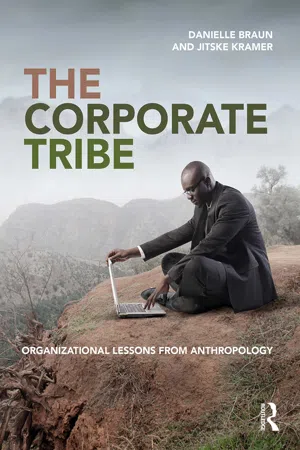
The Corporate Tribe
Organizational lessons from anthropology
- 250 pages
- English
- ePUB (mobile friendly)
- Available on iOS & Android
About This Book
No challenge is entirely new. In 60, 000 years of human existence, nearly every problem we face in modern business has already been seen…and solved. We just have to figure out how to apply that age-old tribal wisdom to our current circumstances.
The Corporate Tribe will take you on a journey to discover the essence of culture and the secret to successful change programs. Along the way, it will introduce you to the cultural traditions of different people across the globe and provide you with the practical tools you need to apply what you find to today's organizations. Through thirty compelling stories, The Corporate Tribe will reveal what, deep down, you already know.
At turns unfamiliar and disruptive, illuminating and inspirational, The Corporate Tribe offers a powerful paradigm and skillset for tackling organizational and leadership challenges in the twenty-first century and beyond. It is a book for leaders, consultants and advisors who are looking for a fresh perspective and proven solutions, for those who want to build strong communities that are safe for diversity and ready for change.
Danielle Braun and Jitske Kramer are corporate anthropologists. They look at organizations as tribes, organizational charts as kinship systems, leaders as chiefs and mission documents as totem poles. Travel with them to places where spirits linger after death, magic is real and rituals are the key to maintaining order and facilitating transition. You will never look at your organization—or approach its problems—the same way again.
Frequently asked questions
Information
PART ONE
Culture Creates Order from Chaos
CHAPTER ONE
Where to Find “Organizational Culture”
People shape cultures and cultures shape people.

How Do People Shape Culture?
Grasping Culture: Three Approaches
- TypologiesOrganizations are described by a cohesive set of characteristics—often with a symbolic or metaphorical name, or linked to particular color schemes. Maybe you have heard of personality and organizational tests like Management Drives and Spiral Dynamics, in which a certain color is assigned to a scored profile. People who have used these models might say things like, “I am more of a red person and I find your blue reaction difficult to handle.” The advantage of typologies is that they instantly provide us with a feeling, summon up a total image, which makes cultures easier to discuss. This simplification is also the disadvantage, however, as the caricature sketched does not offer any room for details and exceptions within the group described; nor does it answer questions on how such a culture was formed and what the internal cohesion or functionality of the cultural patterns are. If you are not careful, working with typologies can become like reading horoscopes: if they are well written, you can always see something in it for you.
- DimensionsIn this view, researchers assume that all cultures share the same dimensions but express different values within them. Researchers use tools, such as questionnaires, to measure select aspects of the organizational culture on a scale of, for example, one to ten. People like Fons Trompenaars and Geert Hofstede have defined a few dimensions that are important in every culture, but have different scores in different cultures. Think of dimensions like Individualism versus Collectivism, Universalism versus Particularism, and High and Low Power Distance (the extent to which the lower ranking individuals of a society accept and expect that power is distributed unequally). The advantage of this approach is that it allows you to compare different aspects of the culture or the development of one aspect over time. Thus you may conclude that the organization has, let’s say, become less normative and more pragmatic over the past three years. The disadvantage of the dimensions approach is that by quantifying intangible processes of signification, it creates a false sense of control and manageability. As if you could alter just one dimension of culture and leave the rest untouched. If you are not careful, the dimensional approach gives a fragmented view of a culture that is best understood as a cohesive whole.
- Grounded theoryAs a researcher, you submerge yourself as much as possible in the actual working environment of the organization in order to discover the structure and meaning that the people themselves assign to their world. You cannot achieve this by working from a previously established hypothesis or typology; rather, you must approach the situation with a completely open mind and allow a picture of reality to emerge. You start by observing, feeling, experiencing and interviewing. You then search for a pattern in your data and construct your theory, which you re-check in the field. You continually fine-tune the theory, often with input from those being researched. The advantage of this approach is that it does justice to the complexity of, and cohesion within, culture. The disadvantage is that, in some cases, it can be quite time consuming, and the validity of the result will depend largely on the skill and personality of the researcher.
Two Stories about Culture
1.1 A 2% Margin of Error
Travel with Us…
Table of contents
- Cover
- Half Title
- Title Page
- Copyright Page
- Table of Contents
- About the authors
- Introduction: A Journey through the Corporate Tribe
- Part 1 Culture Creates Order from Chaos
- Part 2 It Happens in the Relationships
- Part 3 Cultural Transitions—Building and Moving a Totem
- Inspirations and Sources
- Index